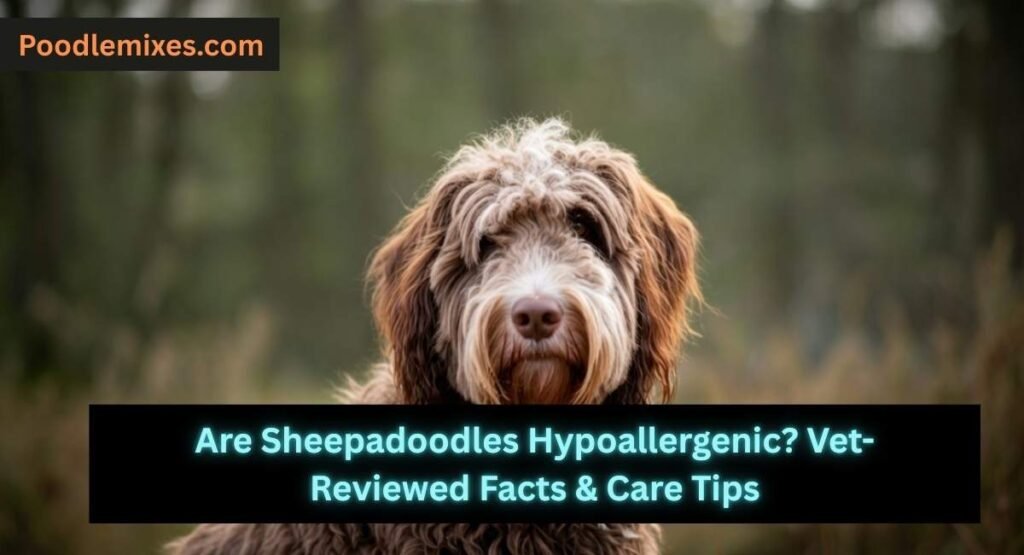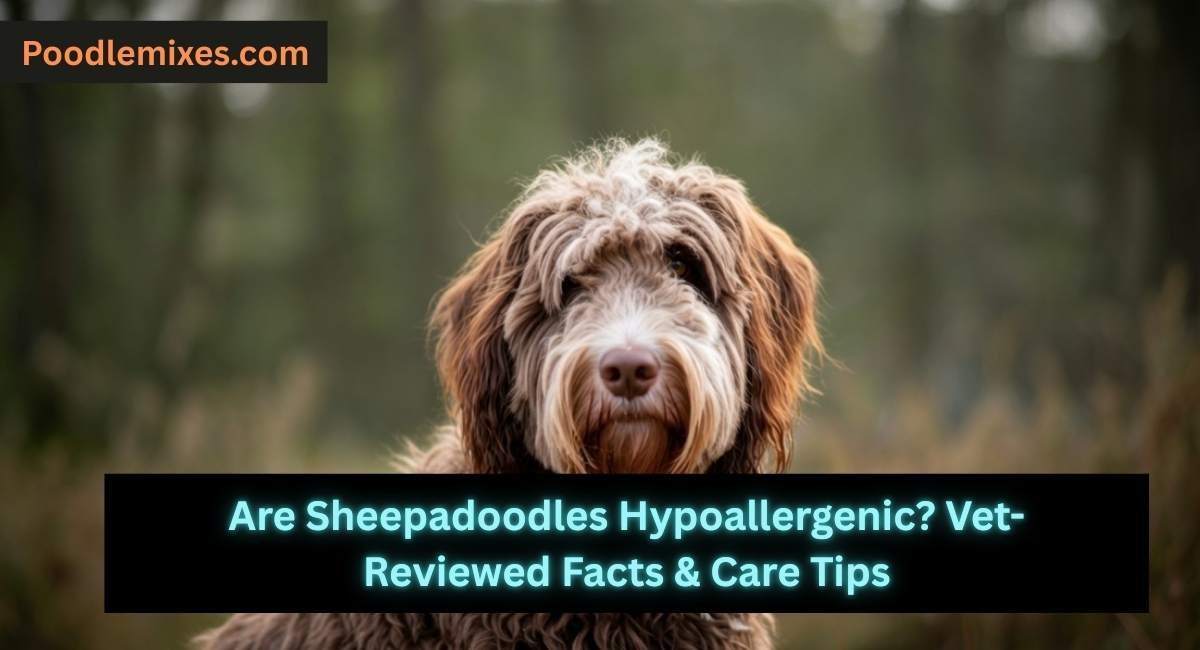Are Sheepadoodles hypoallergenic? This striking mix of an Old English Sheepdog and a Poodle is known for its gentle giant personality and iconic, often low-shedding, coat. For allergy sufferers, the Poodle parentage offers hope. However, it’s crucial to start with a key fact from the American College of Allergy, Asthma, and Immunology: no dog breed is 100% hypoallergenic. While Sheepadoodles can be a better choice for some with allergies, success depends on understanding the science behind pet allergens and the specific traits of this crossbreed. This guide will explore Sheepadoodle coat genetics, allergy science, and effective management strategies.

Are Sheepadoodles Hypoallergenic?
No, Sheepadoodles are not fully hypoallergenic. They are often considered a low-allergen or low-shedding option due to their Poodle genetics, but they still produce the common allergens—proteins in dander, saliva, and urine—that trigger reactions. The American Lung Association confirms that allergies are caused by these proteins, not the hair itself. While a Sheepadoodle’s curly coat may trap dander and reduce its spread into the environment, the allergens are still present. Therefore, calling them “hypoallergenic” is misleading; “more manageable for some allergy sufferers” is a more accurate description.
What Does Hypoallergenic Really Mean in Dogs?
The term “hypoallergenic” suggests a dog is safe for those with allergies, but the veterinary definition is less absolute. “Hypo” means “less,” indicating these breeds are less likely to cause a reaction, not that they are allergy-proof. The American Kennel Club (AKC) categorizes non-shedding breeds like the Poodle as hypoallergenic because they release less dander into the air.
However, scientific evidence tempers this claim. A landmark study in the Journal of Allergy and Clinical Immunology found that homes with so-called “hypoallergenic” dogs had similar levels of allergens as homes with other breeds. This underscores that allergen production is an individual characteristic, and the label is a guideline, not a guarantee.
Sheepadoodle Coat Types and Allergen Impact
A Sheepadoodle’s coat is a wild card, inheriting traits from either the shaggy, double-coated Old English Sheepdog or the tight-curled, single-coated Poodle. This genetic roulette significantly impacts shedding and allergen spread.
The following chart compares the potential Sheepadoodle coat outcomes:
| Coat Type | Shedding Level | Dander Control | Allergy Risk (Relative) |
|---|---|---|---|
| Curly (Poodle-Dominant) | Very Low | Excellent | Lower |
| Wavy/Fleecy (A Balanced Mix) | Low to Moderate | Good | Medium |
| Straight/Shaggy (Sheepdog-Dominant) | High (often seasonal “blowing” of the undercoat) | Poor | Higher |
As noted by VCA Animal Hospitals, a curly, Poodle-like coat is most effective at trapping dander. Conversely, a coat that leans toward the Old English Sheepdog’s double coat will shed more and release more dander into your home, presenting a higher challenge for allergy sufferers.
Allergy Considerations for Sheepadoodle Owners
The suitability of a Sheepadoodle for an allergy-prone home hinges on two factors: the severity of your allergies and the specific coat of the individual dog. Someone with mild sensitivities might thrive with a curly-coated Sheepadoodle, while someone with severe asthma may still react.
Research from the National Institutes of Health (NCBI) shows that allergen levels can vary significantly between two dogs of the same breed. For people asking “are Sheepadoodles hypoallergenic,” the answer is deeply personal. It depends on your immune system and the dog’s unique genetics. Always arrange multiple visits with a specific Sheepadoodle before committing to adoption.
Tips to Reduce Allergic Reactions With a Sheepadoodle
Proactive management is non-negotiable for living happily with a Sheepadoodle and allergies. Their lush coats require diligent care.
- Professional-Grade Grooming: Sheepadoodles need regular brushing (every 1-2 days) to prevent mats and professional grooming every 4-6 weeks. Consistent grooming, as recommended by the AKC, is the single most effective way to control dander and loose hair.
- Establish Pet-Free Zones: Make your bedroom a strict no-dog zone to ensure you have an allergen-free sanctuary for sleep.
- Use HEPA Filtration: Invest in a high-quality HEPA air purifier for the main living areas and a HEPA-filter vacuum cleaner. The EPA notes that air cleaners can significantly reduce airborne allergen levels.
- Bathe Your Dog Regularly: Bathing your Sheepadoodle every 3-4 weeks with a gentle, hypoallergenic shampoo can wash away accumulated dander and saliva.
- Wash Hands and Fabrics: Wash your hands after petting or grooming your dog, and launder their bedding, blankets, and soft toys frequently in hot water.
Other Poodle Mixes Often Considered “Hypoallergenic”
Sheepadoodles are one of several popular “Doodle” mixes. Here’s how they generally compare:
| Breed | Typical Coat | Shedding Level | Allergy Friendliness* |
|---|---|---|---|
| Sheepadoodle | Curly/Wavy/Shaggy | Low–High (varies greatly) | Moderate (depends on coat) |
| Goldendoodle | Curly/Wavy | Low–Moderate | Moderate |
| Labradoodle | Curly/Wavy | Low–Moderate | Moderate |
| Bernedoodle | Curly/Wavy | Low–Moderate | Moderate |
*Friendliness = relative chance of being allergy-manageable, not allergy-free. Individual results will vary.
FAQ Section (People Also Ask)
Do Sheepadoodles shed a lot?
It depends entirely on their coat. A Sheepadoodle with a strong Poodle influence will shed very little. One that takes after the Old English Sheepdog will shed moderately to heavily, especially during seasonal changes when they “blow” their undercoat.
Are F1B Sheepadoodles better for allergies?
Yes, significantly. An F1B Sheepadoodle (an F1 Sheepadoodle bred back to a Poodle) is 75% Poodle. This dramatically increases the odds of a non-shedding, curly coat, making them a much better bet for allergy management than an F1 (50% Poodle/50% Sheepdog) or a straight-coated Sheepadoodle.
Can I live with a Sheepadoodle if I have allergies?
It is possible with careful planning. If you have mild allergies, a curly-coated F1B Sheepadoodle, combined with a rigorous cleaning and grooming routine, may work well. However, for those with severe allergies, it is a higher-risk choice due to the variability in coat type. Consultation with an allergist and a trial visit with the dog are essential steps.
Conclusion
So, are Sheepadoodles hypoallergenic? The consensus is clear: while no dog is completely hypoallergenic, a Sheepadoodle with a Poodle-dominant coat can be a manageable companion for many with allergies. The critical factor is understanding the breed’s coat variability and committing to the significant grooming requirements. By choosing the right individual dog (preferring an F1B), implementing a strict allergen-reduction plan, and consulting with your doctor, you can increase your chances of a happy, healthy life with a Sheepadoodle.
